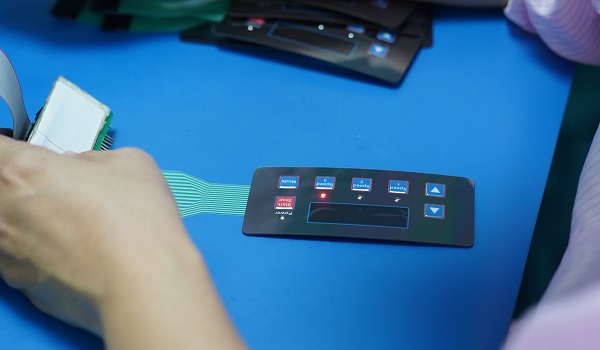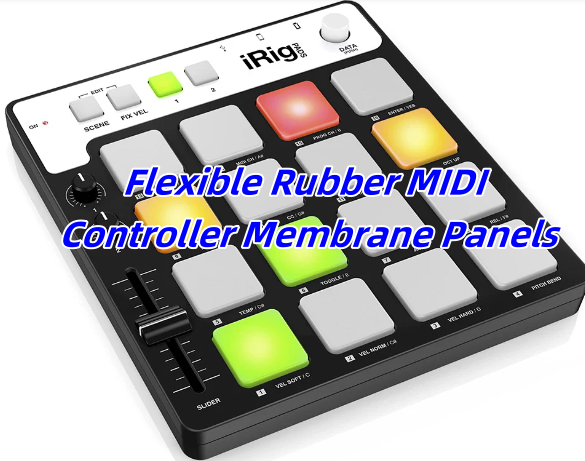
Understanding Membrane Switches and Their Functionality
Understanding Membrane Switches and Their Functionality
A membrane switch is a tool that helps people control machines. It works as a device that connects you to the machine. These switches are used in medical tools, factory machines, and home gadgets. They are important for clear and accurate communication. The market for membrane switches is growing fast. It is expected to grow from $4.4 billion in 2024 to $7.2 billion by 2034. This technology is changing how we use modern devices every day.
Key Takeaways
- Membrane switches are strong and can handle over 1,000,000 presses. This makes them great for devices used often.
- These switches can be customized with features like lights and touch feedback to improve how they feel to use.
- Membrane switches are affordable because they are simple and need little care. This makes them a good choice for companies.
- They work well in many fields like healthcare, gaming, and automation. They are trusted because they last in tough conditions.
- Membrane switches mix the good parts of buttons and touchscreens. They are strong, cheap, and still work really well.
What Is a Membrane Switch?
Definition and Purpose
A membrane switch is a way to control electronic devices. It works by sending signals when you press a button or touch it. These switches are made of thin layers of flexible materials like plastic. The layers are stacked to create a small and efficient design.
Unlike regular mechanical switches, membrane switches open or close circuits temporarily. This makes them light, strong, and easy to care for. They are also water-resistant and affordable, which makes them useful in many areas. From home gadgets to factory machines, they make using devices simple and reliable.
Tip: Membrane switches are great for tough conditions like heat and moisture.
Common Applications of Membrane Switches
Membrane switches are used in many fields because they are tough and flexible. Here’s a table showing where they are commonly used:
| Manufacturer | Applications |
|---|---|
| Backlit Keypads Manufacturers | Medical, military, consumer, food equipment, and avionic industries. |
| Electronic Keyboards, Inc. | Fast food systems, retail systems, factories, machine controls, control rooms, and automation. |
| Got Interface | Cell phones, POS terminals, alarm systems, time & attendance equipment, printer controls. |
In healthcare, they are found in medical tools like monitors and diagnostic machines. Their small size and liquid resistance make them perfect for clean environments. In telecom, they are used in phones and alarms, where space and reliability matter. Remote controls and gaming devices also use them for their sleek look and easy use.
In factories, they are part of automation systems and machine controls. They handle heavy use and tough conditions well. They are also used in fast food and retail systems, where quick and accurate input is needed.
Did You Know? Membrane switches can last over 1,000,000 uses, making them very durable.
Membrane switches are not only useful but also customizable. They can include features like lights, feedback when pressed, and special designs. This makes them fit many industries, from medical tools to everyday gadgets.
How Are Membrane Switches Made?
Important Layers in a Membrane Switch
Membrane switches have several layers, each with a specific job. These layers include the graphic overlay, adhesive, circuit, and spacer. The graphic overlay is the top layer where you press buttons. It shows the design and labels for the buttons. Below it, the circuit layer has conductive paths that complete the circuit when pressed.
Membrane switches are built to last a long time. They can handle up to 1,000,000 presses. Materials like polycarbonate are tested to ensure they meet this standard. The pressure needed to press the switch, called actuation force, ranges from 170 to 680 grams. This can be adjusted based on what you need.
Materials Used in Membrane Switches
Membrane switches use strong materials to work well and last long. Polycarbonate and polyester are used for the graphic overlay because they are flexible and tough. Conductive inks, made of silver or carbon, are used in the circuit layer to carry electricity.
Manufacturers test these materials in different conditions to make sure they work. High heat and moisture tests check if the materials age or lose insulation. Static electricity tests ensure the switches can handle shocks safely. These tests make membrane switches reliable in tough environments.
| Test Type | Purpose |
|---|---|
| High Heat and Moisture | Checks how materials handle aging and insulation in extreme conditions. |
| Cold and Dry Conditions | Tests flexibility and responsiveness in freezing and dry environments. |
| Insulation Breakdown | Measures how much voltage the insulation can safely handle. |
| Static Electricity Resistance | Ensures switches can handle static shocks without failing. |
Custom Designs for Different Uses
Custom membrane switches are made to fit specific needs. Manufacturers work with you to create switches for your application. Custom designs can include features like backlighting, tactile feedback, or unique shapes.
Special techniques improve how the switches feel and work. Tactile feedback uses metal domes to make a snapping sound when pressed. Conductive inks keep the switches working well over time. These features make custom switches great for industries like healthcare, telecom, and factories.
| Manufacturing Process | Description |
|---|---|
| Tactile Feedback | Metal domes create a snap sound when pressed for better feel. |
| Conductive Inks | Used to keep switches working reliably over time. |
| Custom Switch Design | Designed with customers to match specific needs. |
Custom membrane switches mix good design with flexibility, making them useful for modern devices.
How Do Membrane Switches Work?

The Role of Each Layer in Functionality
Each layer in a membrane switch has an important job. The top layer, called the graphic overlay, shows the buttons and labels. This layer helps you know where to press to control the device. Below it, the spacer layer keeps the circuit open until you press a button. It stops accidental activation by separating the conductive layers.
The circuit layer is under the spacer and has paths made of silver or carbon ink. When you press the overlay, the spacer pushes down, letting the circuit layer touch the bottom layer. This sends an electrical signal to the device, making it respond to your action.
Adhesive layers hold all the parts together and keep them safe. They protect the switch from dust, water, and other damage. Together, these layers make the switch work smoothly and reliably.
Tip: Tactile feedback, like a snap sound, comes from the circuit layer or metal domes.
Circuit Activation Process
The circuit activation process in membrane switches is simple and exact. Pressing a button pushes the top layer down, moving the spacer. This lets the conductive paths in the circuit layer touch the bottom layer, completing the circuit. The completed circuit sends a signal to the device, telling it what to do, like turning on or off.
The speed and accuracy of this process depend on the materials and design. For example, how fast the switch works can change based on its use. The table below shows some findings:
| Evidence Description | Activation Timing | Response Rate |
|---|---|---|
| FEF switch dynamics | > 100 ms | Low to high firing rates transition |
| Bursting neurons (Boucher et al., 2007) | Few msec | Rapid transition observed |
| Threshold Layer activation | Gradual ramping observed | Consistent across conditions |
These results show how membrane switches can be adjusted for different needs. They can work slowly or quickly, depending on the situation. This makes them great for things like medical tools and factory controls.
Did You Know? Tactile feedback helps you know when a button is pressed correctly.
Examples of Membrane Switches in Use
You can find membrane switches in many devices you use daily. In healthcare, they are in machines that check patients and monitors that need exact control. Remote controls also use them because they are thin and easy to press.
In factories, membrane switches are part of machines that handle tough conditions like heat and chemicals. Fast food places use them in order systems for quick and accurate input.
Gaming devices depend on membrane switches for their fast response and long-lasting use. The feedback makes sure every press counts, improving the game experience. Whether at home, work, or a hospital, membrane switches are a reliable way to control devices.
Note: Features like backlighting and custom designs make membrane switches useful for many industries.
Advantages of Membrane Switches
Durability and Cost-Effectiveness
Membrane switches are strong and last a long time. Their layers protect them from damage, even in tough conditions. They work well in places with moisture, heat, or heavy use. Unlike mechanical switches, they have fewer moving parts. This means they break less often and last longer.
Making membrane switches costs less than other options. Their simple design and light materials keep prices low. Industries like healthcare and electronics use them because they are affordable. They also need little maintenance, saving money over time. Their strength and low cost make them a smart choice for businesses.
Tip: Membrane switches can handle over a million presses, making them perfect for frequent use.
Design Flexibility and Aesthetic Benefits
Membrane switches can be designed in many ways. Manufacturers can add features like lights, textures, or feedback when pressed. Their thin design fits easily into small devices without making them bulky.
They also look good and are practical. Matte finishes hide scratches, keeping them neat. LED lights help you see buttons in the dark, making them useful at night. The table below shows features that improve their design and look:
| Feature | Description |
|---|---|
| Customization Capabilities | Membrane switches can be made to fit user needs, like adding lights or feedback. |
| Low-Profile Design | Their thin design fits into small devices without extra bulk. |
| Selective Texturing | Matte finishes reduce scratches and improve appearance. |
| LED Backlighting | Built-in lights make buttons easy to see in dim areas. |
These features make membrane switches useful and attractive for modern devices.
Comparison to Mechanical Switches and Touchscreens
Membrane switches combine the best parts of mechanical switches and touchscreens. Mechanical switches are strong but big, while touchscreens are sleek but costly. Membrane switches are both durable and affordable.
They are lighter and easier to fit into small devices than mechanical switches. They also handle moisture and dust better than touchscreens. Unlike touchscreens, membrane switches use simple designs. This makes them reliable and cheaper to produce.
Note: Membrane switches give feedback when pressed, which touchscreens often don’t. This helps users know their input was received.
Membrane switches are better than mechanical switches and touchscreens in many ways. They are strong, affordable, and flexible, making them a top choice for many industries.
Membrane switches are important in today’s technology. They help people control devices easily and reliably. These switches are strong, affordable, and can be designed in many ways. Their layers make them work smoothly, and they can be customized for different uses. You’ll find them in medical tools, gaming devices, and more. They improve how devices work and last in tough conditions. If you need something precise or durable, membrane switches are a great choice.
FAQ
What makes membrane switches different from mechanical switches?
Membrane switches are thin, light, and cost less than mechanical ones. They have fewer parts, so they last longer. Mechanical switches are bigger and more expensive but feel better to press. Membrane switches mix strength with a slim look, perfect for modern gadgets.
Can membrane switches work in extreme environments?
Yes, membrane switches can handle tough conditions. They resist water, heat, and dirt. Makers test them to ensure they survive high temperatures and static shocks. This makes them great for healthcare, factories, and outdoor tools.
How long do membrane switches last?
Membrane switches can be pressed over 1,000,000 times. Their strong materials and simple build make them last a long time. Tests confirm they meet strict rules, making them a smart choice for devices used often.
Are membrane switches customizable?
Yes, you can design membrane switches to match your needs. Add features like lights, feedback, or special shapes. Makers work with you to create designs for your use. This makes them useful for telecom, healthcare, and gaming.
Do membrane switches provide tactile feedback?
Yes, many membrane switches give feedback when pressed. Metal domes or other methods make a snap sound or feel. This helps you know the button worked, making it easier to use.
Tip: If you want feedback, ask the maker to add it.

When designing a user interface, lighting can make all the difference. Whether it’s a piece of medical equipment, a control panel in a factory, or the dashboard of a smart appliance, membrane switch lighting creates a better experience for the user. Two popular options, backlit membrane switches and edge-lit membrane switches, offer unique ways to ...

The membrane switch is a control system that integrates key functions, indicating components, and instrument panels. It is beautiful, lightweight, has excellent conductive properties, and has the characteristics of waterproof, dustproof, and anti-static interference. It is widely used in electronic communications, medical equipment, industrial control, Instrumentation, automotive industry, smart home and other fields. The following ...

What Is a Flexible Rubber MIDI Controller? A flexible rubber MIDI controller is a game-changer for musicians, producers, and performers. Unlike the stiff, traditional controllers, these are soft, lightweight, and, most importantly, flexible. They’re made with special rubber that feels great to touch and offers a unique level of interaction. These controllers are ideal for ...

Know the Difference between Tactile and Non-Tactile Membrane Switching
When selecting the appropriate interface for a product, it can be wise to understand the differences between tactile and non-tactile membrane switches so that the engineer and the purchaser make a better decision. They are both very common in medical equipment, domestic appliances, and industrial equipment, though they do not present the same user experience. ...

Step-by-Step Guide to Selecting the Right Membrane Switch for Your Product
It is not easy to choose the appropriate interface for an electronic device with the number of various types of membrane switches. This is a basic, stepwise analysis to help product designers and manufacturers select the optimal choice. Step 1: Determine your Application Requirements Begin by making a list of locations where switches are used, ...

Top Membrane Switches for Home Electronics Projects in 2025
You can elevate your home electronic membrane switch project in 2025 with standout models such as the 4×4 Matrix 12 Keys Keypad from SOUSHINE, the rgb-enabled strip switches from Molex, and custom graphic switches by Panasonic. These switches offer slim profiles and reliable performance, making them easy to integrate into your DIY setup. You gain ...
Contact us online